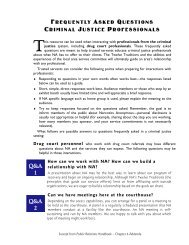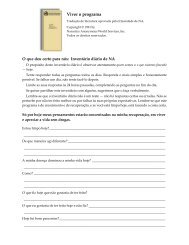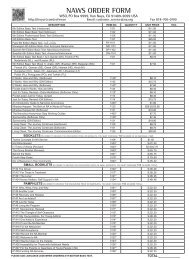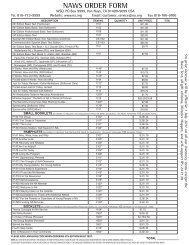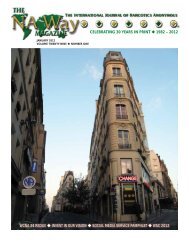Public Relations Handbook - Narcotics Anonymous
Public Relations Handbook - Narcotics Anonymous
Public Relations Handbook - Narcotics Anonymous
You also want an ePaper? Increase the reach of your titles
YUMPU automatically turns print PDFs into web optimized ePapers that Google loves.
P u t t i n g y o u r p l a n i n t o a c t i o nInteracting with facility staffNA members will need to interact with the personnel at correctional facilities toestablish a meeting, panel, or ongoing relationship with that facility. Thoseinteractions are crucial to long-lasting relationships with local correctional facilities. Itis often the manner in which we interact that is most important to our publicrelations. Our attitudes, our language, and our willingness to work cooperativelywith organizations to reach more addicts are the foundation of our PR efforts. Thefollowing points can help members make those interactions more successful: Create a realistic picture of what NA can and cannot do. Make commitments that the area service committee can reasonably expect tofulfill. Maintain a dialogue with the facility. Make regularly scheduled check-ins so thosewho work at the facility are aware of NA’s status. Be sure to update trustedservants’ contact information with the facility and explain that, because werotate positions, there may be different people coming into the facility. Ask to be introduced to the facility’s staff and to be made aware of thefacility’s policies and procedures in writing, such as whom to notify in case ofan emergency, whether personal identification is needed to enter the facility,when to sign in, etc. Be sure to share the information with those entering thefacility. Discuss proposed meeting formats, and clarify whether correctional officers willbe in attendance at the meeting. Inquire with facility staff about whether refreshments (such as coffee, tea, andsnacks) are welcome at institutional meetings. Regularly ask the staff if NA seems to be meeting the needs of the inmates. Make the facility aware of free periodicals such as Reaching Out and The NA WayMagazine (provided through NA World Services) and NA literature available forpurchase. If there are any problems with a panel in a facility, we can schedule a meetingwith correctional staff to find solutions. A strong relationship with the staffhelps us to better reach our goals of carrying NA’s message, especially whenproblems arise. For more practical suggestions, see the “Dos and Don’ts” at the end of thischapter.Juvenile-detention facilities and youthful offendersMuch of the prior information about correctional institutions, jails, and prisonsapplies to juvenile-detention facilities (including reform schools) and youthfuloffenders. Trusted servants entering juvenile-detention centers may want to reviewthe training points listed in the previous section first. What follows is additionalinformation that is especially important when interacting with this population.Facility rules and local lawsIt is important to be very clear about the rules and regulations of the facility andlocal laws. Minors are often under more restrictive legal protection. This may meanavoiding any sort of physical contact, including hugs. The best rule is to have no54 | Chapter 6 | Criminal Justice





